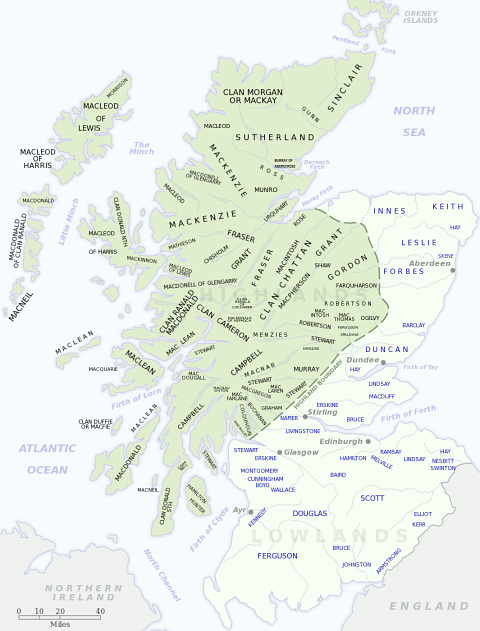
Motto: Virtutis gloria merces (Glory is the reward of valour)
Historic Seat: Dun Alastair
District: Perthshire
Associated Surnames: Collier, Colyear, Dobbie, Dobson, Donachie, Duncanson, Dunnachie, Hobson, Inches, MacConachie, Maconnechy, MacConochie, MacDonachie, MacInroy, MacLagan, MacRobbie, MacRobert, MacRobie, Roberts, Robinson, Robison, Robson, Roy, Stark, Tonnochy
Associated Tartans:
Early Robertson Genealogy and History:
(Excerpt from "The Scottish Clans and Their Tartans", James Grant, 1906)
This tribe is called by the Highlanders the clan Donnachie, being descended from the family of Atholl, which was the designation of the ancestors of the chiefs of the clan for four centuries; "and it distinctly points out," says James Robertson, "that they must derive from the ancient Celtic Comes de Atholia; and, like other clans, they appear in independence upon the extinction of the Celtic Earls, and were in possession of very large landed properties in the north and west of Perthshire. As to the descent of the chiefs of the clan, and which has always been allowed by themselves, it is from the MacDonalds."
The Robertsons adhered to Bruce in his struggle for the throne; and in one of the two isles in Loch Rannoch, about 1338, MacDougal, who was taken prisoner in a battle, was confined by the chief of the Clan Donnachie, named Donachadh ramhar, or the Robust.
In the reign of David II (1330-70) William Robertson and John Reidheuch got a charter of the lands of Loch-house, "whilks were William Mairis, and gave them to the foresaid persons in Viecome. de Linlithgow."
Duncan, chief of the Clan Donnachie, died in or about 1355. His sons were Robert of Atholl, ancestor of the line of Struan, and Patrick, ancestor of the line of Lude, who got a Crown charter for that barony in 1448. The next oldest families of the clan were the Robertsons of Strathloch, Faskally, etc.
The Robertsons first appear as a clan in 1391, when in a body they attacked the Lindsays for depriving them of some property at Glenesk, in Aberdeenshire. They were opposed by Sir Walter Ogilvie, the Sheriff of Angus, and others. A battle took place at Glascony, where Ogilvie and many Lowland barons were slain; and again, when the clan were followed to their own country, at a second battle in Glenbrerachen, in Atholl, the Clan Donnachie were again victorious.
In 1437 Robertson of Struan, having apprehended some of the murderers of James I, received for a crest a hand holding an imperial crown, with the motto Vertutis Gloria Merces,, "and on a complement, a wild man chained."
In 1483 Bernard Stewart, Lord Aubigne, Marshal of France, went back to that country, taking with him eighteen companies of Scottish Infantry under Donald Robertson, an expert and gallant commander. In 1516 he has another and a different notice: "Donald Robertson of Strowan, for mony willanes (sic) committed by him, is beheadit at Logereat this zier, by the Governor's command."
Donald Robertson of Struan, in Atholl, appears a chief in the Roll of the Clans in 1587.
In 1646 the clan joined the army of Montrose, 800 strong, under Donald, the tutor of Struan, as his nephew, the chief, was then a minor. His commission as Colonel was dated 9th June.
"The Clach-na-Bratach," or Stone of the Standard, was carried on the person of the Chief in battle as a guarantee of victory. It was found one day adhering to the pole of the standard when drawn out of the earth, and was preserved as sacred. The stone was probably a Druidical beryl, and was discovered in the twelfth or thirteenth century.
The residence of the chiefs of the clan was at Dun Alister, at the east end of Loch Rannoch, a place that derives much interest form its connection with the well-known Jacobite poet, Alexander Robertson of Struan, during the insurrections of 1715 and 1745. He was "out" in both. In the former he led 500 Robertsons at Sheriffmuir,1 under the clach-nan-brattich, and was forfeited, but restored. In 1745 his estates were annexed to the Crown, notwithstanding which, he returned and lived on his property, and died in 1749 in his eighty-first year, "a poet and a sot," as Dr M'Culloch has it. In the year of Culloden2 the fighting force of the clan was 700 men.
Alexander Robertson of Struan was succeeded by his kinsman, Duncan Robertson of Drumachine, whose grandson, Alasdair, is the present Robertson of Struan.
At Dun Alister nothing remains now of the chiefs of the Clan Donnachie but their burial-place, a melancholy and neglected spot, surrounded by a wall, and choked with weeds and gigantic nettles.
(End excerpt)
Next page: Clan Rose
Footnotes:
1 The Battle of Sheriffmuir (1715): The Battle of Sheriffmuir was fought on 13 November 1715, led by John Erskine, 6th Earl of Mar, standard-bearer for the Jacobite cause in Scotland, and British Government forces, led by John Campbell, 2nd Duke of Argyll. It took place on the slopes of the Ochil Hills in Scotland, just inside the Perthshire border. Read more about the Battle of Sheriffmuir at Wikipedia.
2 The Battle of Culloden (1746): The Battle of Culloden was fought on 16 April 1746, on Drummossie Moor, near Culloden, east of Inverness Scotland, between Scottish forces led by Charles Edward Stuart (Bonnie Prince Charlie) and English forces led by William Augustus, Duke of Cumberland. It was the final confrontation of the Jacobite rising of 1745. Read more about the Battle of Culloden at Wikipedia.

Distribution of Scottish clans and families
View larger map at Wikimedia Commons

Browse the Clan Robertson Tartan Collection with home decor, personal accessories, crafting, paper products, and more.

Browse the Perthshire District Tartan Collection with home decor, personal accessories, crafting, paper products, and more.

Clan Robertson Postcard: Digitally cleaned and enhanced vintage illustration with tartan border.